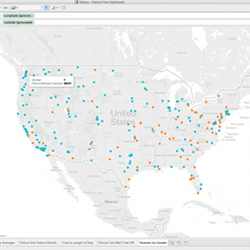
Organizations are uncovering more value from the data in their systems thanks to analytics tools that let them hone in on information to make predictions and better decisions.
While two decades ago such analytics capabilities would have required a dedicated, expensive supercomputer the size of an entire room, "data integration, data analytics and data visualization technologies are now so advanced that it is possible, practical, and affordable to ask very complex questions and get quick, accurate answers that inform specific situations," according to audit, tax, and advisory firm KPMG.
Predictive analytics is proving to have powerful benefits in a wide range of industries for improving areas such as customer relationships, pricing optimization, improper public benefits payments and insurance fraud, according to the white paper "Predictive Analytics: The rise and value of predictive analytics in enterprise decision making" from business process services company CGI. Use of predictive analytics in healthcare is already significantly changing patient outcomes by leveraging data captured in electronic health records (EHRs).
"Healthcare is on the verge [of] a radical transformation that will be driven by the increased availability of vast amounts of electronic data, and the use of big data/predictive modelling methods that can mine this data to improve patient care,’’ says Bharat Rao, national leader for healthcare data analytics at KPMG. "Healthcare reform is tying the financial reimbursement of healthcare providers to the quality of care they provide to their patients."
As a result, health systems are beginning to use predictive models to identify patients at high risk for poor outcomes, such as those most likely to be readmitted to medical facilities, Rao says, to identify the patient factors that are early indicators of problems, and to even recommend patient-specific interventions likely to improve patient prognoses. This will continue to increase over the coming decade, he adds.
Healthcare analytics company Jvion is providing insight to healthcare providers into which patients will have what types of conditions in real time, well before any clinical symptoms would be present, says COO Ritesh Sharma. The company’s goal is to provide that data before potential complications can occur, Sharma adds. "We have a patient-focused mission of helping hospitals and healthcare companies prevent patient complications and making sure we’re getting the most accurate predictions to those providers in time to prevent something from happening."
If a patient goes into the hospital for a hip replacement, for example, Jvion’s platform would inform providers that on the second day of his or her stay, based on statistical data, that person could develop Stage 3 bed sores—which would not only require them to stay in the hospital longer, but complications from that could lead to increased mortality rates, Sharma says.
"I would get those predictions to the nurse whose job is to prevent bed sores and they’d go in and intervene by turning the person more or putting them on a different mattress or cushion and would prevent that from happening,’’ he says. Similarly, if a woman enters a hospital to give birth, she might develop some type of infection while there. "The system would be able to tell with a very, very high degree of accuracy that this person would have this event. This allows me to target additional protocols for additional patients."
The Jvion system was built on data models around 16 different hospital-acquired conditions, including infections, urinary tract infections, bed sores, and acute myocardial infarction, as well as readmission rates, Sharma says. The system was designed using a proprietary set of clinical algorithms combined with advanced machine learning techniques, along with some pretty robust rules and other techniques used in the "intent-driven search world" to yield a high real-time accuracy on what is going to happen to a patient while in the hospital, Sharma says.
The system also contains data Jvion has collected over a long period of time from EHRs and administrative data from "tens of millions of unique patients,’’ Sharma says. Added to the mix is socioeconomic data from census reports. Jvion is also using data visualization technology from Tableau Software that lets users view analytics information on their desktop or mobile devices.
Use of predictive analytics in healthcare is becoming more critical since the well-being of a patient even after they are discharged is a key element of the federal Healthcare Reform Act, designed to help ensure patients are not readmitted to hospitals within 30 days, he says. In fact, the U.S. Centers for Medicare and Medicaid Services (CMS) are now required to reduce payments to hospitals with "excessive readmissions."
Predictive analytics is also making strides in the insurance industry, in areas including risk management, detecting fraudulent claims, improved customer service, and a reduction in handling claims costs.
"Predictive models provide an extremely effective way to get more value from data, and they have a wide range of applications that have not come even close to being fully exploited yet,’’ according to the CGI report. "The big data phenomenon will only increase the number of high-value uses for predictive modeling in government and industry."
Esther Shein is a freelance technology and business writer based in the Boston area.



Join the Discussion (0)
Become a Member or Sign In to Post a Comment